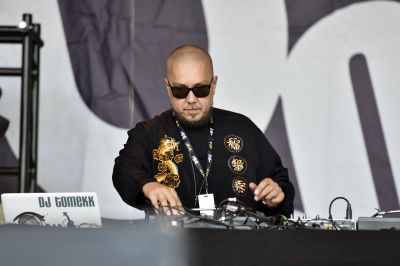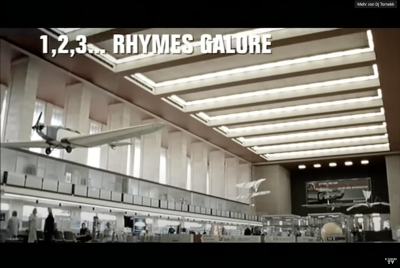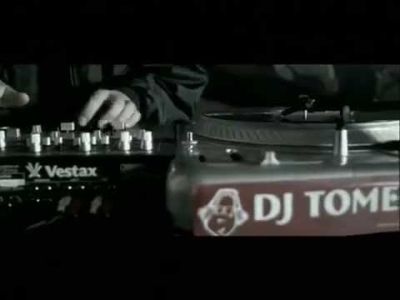He lives for hip-hop: the legendary DJ Tomekk

At just 15, Tomasz signed his first record deal as a rapper with the “Stuff Records” label and released his first single under his rap moniker “MC Mis One” with the songs “Wait In Love For You” and “Art Gangster Rap”. He gained his first experience as a touring DJ with the Berlin musicians’ collective “Reality Brothers”. Starting in 1992, he DJ-ed in the “Acud” club in Berlin on Friday nights. As the weeks went by, the dancefloor grew fuller and fuller; in time, he became known in the Berlin scene under his new artist’s name “DJ Tomekk” (“Tomek” is a pet name for Tomasz; the added “k” stands for his surname, Kuklicz). In 1993, he began working as a DJ with the new Berlin-based radio station “Kiss FM”, presenting his own hip-hop show, “Boogie Down Berlin”, in German, Polish and English. Every Friday and Saturday evening, he mixed his music, interviewed well-known musicians and other guests, and even rapped himself in different languages for his steadily growing audience. It was thanks to his extraordinary talent and a stroke of luck that he got his major break in the music business. In 1993, the US hip-hop legend Kurtis Blow came to Kiss FM for an interview with the now 17-year-old Tomekk and was immediately impressed by his skills. That same evening, Kurtis Blow took the ambitious young Tomekk with him to his concert in Berlin as the opening DJ – and then contracted him to join him on tour through the US. A year later, Tomekk toured the US as a DJ with Kurtis Blow, played at concerts all over the country in front of several hundred thousand people, and was suddenly sharing a stage with the stars of the US hip-hop scene, including Run-D.M.C. and LL Cool J. Kurtis Blow acted as a mentor to the young Tomekk, and made sure that he got a good reception in the hip-hop scene. Regardless of the “East Coast vs. West Coast” conflict that raged in the US hip-hop world and which divided it into two enemy camps during the mid-1990s, Kurtis Blow, who did not have to stoop to such low-level arguments, introduced Tomekk to all the famous hip-hop artists from the East and West Coast alike. At that time, a white non-American was almost unheard of in the US hip-hop scene. It caused a huge stir, therefore, when in 1994 Tomekk was nominated for the “1st Annual Rap Music Award”.
After returning to Germany, Tomekk went back to school. However, he never got around to taking his “Abitur” school-leaving exams. While he may have sat in the classroom during the day, he spent the nights in various Berlin clubs, became joint owner of smaller and bigger club venues, and worked hard on furthering his career as a DJ. He sold his mix tapes, on which he frequently blended US and German artists into one song, from the boot of his car, as it were, and in so doing, bolstered his still very meagre bank balance. Once he came of age, he left the children’s home in Wedding and moved into his first apartment, before later renting a room in a shared flat with friends. In 1997, he signed a contract with the music executive Guido Schulz. From then on, he celebrated one success after another. He left school to work on productions in the major music studios, met real music producers, and took on remix contracts for artists who were friends. In 1998, together with Guido Schulz and his flatmate at the time, now the successful music manager Ronny “Ernie” Boldt, he founded the “Hip-Hop-Büro Berlin” DJ promotion agency. And when the sportswear brand Fila founded the “F-Records” label in 1999, Tomekk was one of the first artists to sign a contract. The song “1, 2, 3 Rhymes Galore”, an international cooperation between DJ Tomekk and Grandmaster Flash, became a huge commercial success and remained in the German charts for several weeks. His second single, “Ich lebe für Hip Hop” (“I live for hip-hop”) reached no. 11 on the charts. Even at this early stage, the hip-hop anthem became his signature trademark, reaching beyond his own musical milieu. He began appearing on TV, recorded songs such as “Comet” and “Bravo-Otto”, gave autograph sessions and received requests for bookings all over Europe. In 2001, he released his first album, “Return of Hip Hop”, and moved to New York that same year. Since then, he has recorded with major international stars and has enjoyed international chart success. At the dawn of the new millennium, Tomekk was one of the most famous hip-hop DJs and most sought-after producers in Germany. He helped a large number of German rappers gain success in the charts and brought US hip-hop artists to Germany, including LL Cool J, Coolio, Grandmaster Flash, Public Enemy, KRS One and the Wu-Tang Clan. A second studio album, “Beat of Life, Vol. 1” followed in 2002. In 2003, it was even nominated for a Grammy Award. In 2005, he released his third album, “Numma Eyns”, from which the single “Jump Jump (DJ Tomekk kommt)” made it to no. 3 on the German charts. The music video that accompanied the song was most expensive German hip-hop video to date.





